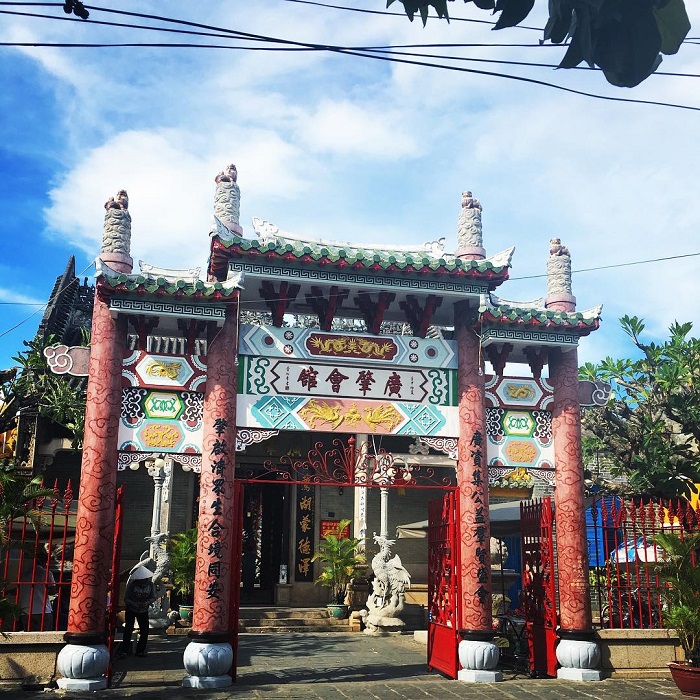Hoi An Cantonese Assembly Hall – The Fusion of Vietnamese and Chinese Cultures
The Hoi An Cantonese Assembly Hall is known as an important historical monument in Hoi An’s Old Town. With its architectural style influenced by the Chinese, it is a place that attracts many visitors for exploration and discovery. The Hoi An Cantonese Assembly Hall is located in the central part of Hoi An’s Old Town and holds special significance in the beliefs of the early Chinese settlers in the area. If you plan to visit Hoi An’s charming streets, don’t forget to include this unique destination in your itinerary.

Address of the Hoi An Cantonese Assembly Hall Address:
176 Tran Phu Street, Hoi An City, Quang Nam Province. Opening hours: 6:00 AM – 4:00 PM The Hoi An Cantonese Assembly Hall is situated on Tran Phu Street, known as the “heritage road,” which features many significant historical architectural structures. Located in the heart of Hoi An’s Old Town, it attracts numerous daily visitors who come to learn about its history and cultural significance.
Exploring the Ancient History of the Hoi An Cantonese Assembly Hall
2.1. Historical Origins of the Hoi An Cantonese Assembly Hall In the past, from the 15th century to the 19th century, Hoi An’s Old Town was a bustling international trading port that attracted many Chinese immigrants for business and livelihood. The Cantonese Assembly Hall was constructed in 1885 during the 18th century by a Chinese merchant. Initially, it was dedicated to Confucius and the Holy Mother Thien Hau, but in 1911, its purpose was changed to worship the Deities of Pioneers and Guan Gong.
This place held significant religious and community importance for the Chinese merchants, serving as a gathering place for community meetings and mutual assistance in both life and business affairs.
2.2. Significance of the Name “Hoi An Cantonese Assembly Hall” The Hoi An Assembly Hall is also known as the Quang Trieu Assembly Hall or the Ong Pagoda because it houses the altar of Quan Cong, a renowned Chinese general. According to Chinese beliefs, Quan Cong, with the six virtues of “loyalty, justice, faith, intelligence, benevolence, and bravery,” brings good luck and prosperity to businesses. This makes him an essential deity for businesspeople.

Hoi An Cantonese Assembly Hall – A Fusion of Vietnamese and Chinese Cultures
3.1. Unique Architecture of the Hoi An Cantonese Assembly Hall The architecture of the assembly hall combines wood and stone in a harmonious manner. The intricate and meticulous decorative details give the assembly hall a distinctive and unmissable appearance. The building is enclosed in the shape of the character “quốc” (國) on an elevated platform and includes a triple gate, a courtyard with ornamental trees, a screen wall, two lateral buildings, the main hall, and a rear courtyard.
- Triple Gate: Upon entering the gate, visitors are greeted by three large paintings of three famous generals from the Three Kingdoms period: Liu Bei, Zhang Fei, and Guan Yu.
- Front Hall: This large hall features stone walls with exquisite carvings, and its multi-tiered roof stands tall with intricate patterns reminiscent of ancient tales.
- Courtyard: The spacious courtyard is adorned with carefully tended ornamental trees and plants. In the center of the courtyard is a large pond with a sculpted dragon, representing the ancient legend of “carp turning into a dragon.”
- Main Hall: This extensive space features massive columns that support a central altar dedicated to Quan Cong, with two side altars dedicated to the Deities of Pioneers and the Spirits of Wealth.
- Antechamber: Located to the right of the main hall, this is where important meetings and gatherings take place.
- Rear Courtyard: The assembly hall boasts a large rear garden with lush greenery. The highlight is a dragon-shaped water fountain with intricate carvings, along with a large mural of General Van Truong.
3.2. Ancient Artifacts within the Hoi An Cantonese Assembly Hall
Hall still houses valuable ancient artifacts, including four large horizontal lacquered boards, a pair of precious jade pedestals from China, a bronze incense burner that stands 1.6 meters tall, and more. The most notable artifact is the painting of General Quan Cong on horseback, prominently displayed on the stone wall of the assembly hall. According to the tour guides at the Hoi An Cantonese Assembly Hall, this painting is associated with a real historical event in ancient China.
3.3. Traditional Activities at the Hoi An Assembly Hall Every year, during the first lunar month, the assembly hall holds the Nguyen Tieu Festival to pray for favorable weather, prosperous business, and community gatherings. Additionally, on the 24th day of the 6th lunar month, a grand Quan Cong Veneration Festival is celebrated to pay respects to the famous general. This is a fascinating event in Hoi An that you shouldn’t miss.
Important Notes When Visiting the Hoi An Cantonese Assembly Hall
- Appropriate Attire: As a tourist attraction, it’s important to choose appropriate clothing when visiting the assembly hall. Avoid wearing short pants or dresses, spaghetti straps, or excessive makeup.
- Respectful Behavior: Visitors should maintain a respectful demeanor while exploring the assembly hall. Avoid speaking loudly or engaging in laughter, as this is considered disrespectful. Help preserve the cleanliness and solemnity of the environment by disposing of trash in designated areas.
- Recommended Accessories: It’s advisable to wear comfortable shoes (e.g., flat shoes) and bring accessories such as umbrellas or sunscreen to facilitate your exploration of various tourist spots in Hoi An.
The Hoi An Cantonese Assembly Hall is not only a historical and cultural treasure but also a symbol of the fusion of Vietnamese and Chinese influences in the region. Visiting this site will provide you with a deeper understanding of Hoi An’s rich heritage and cultural diversity.
See more: Japansese bridge

